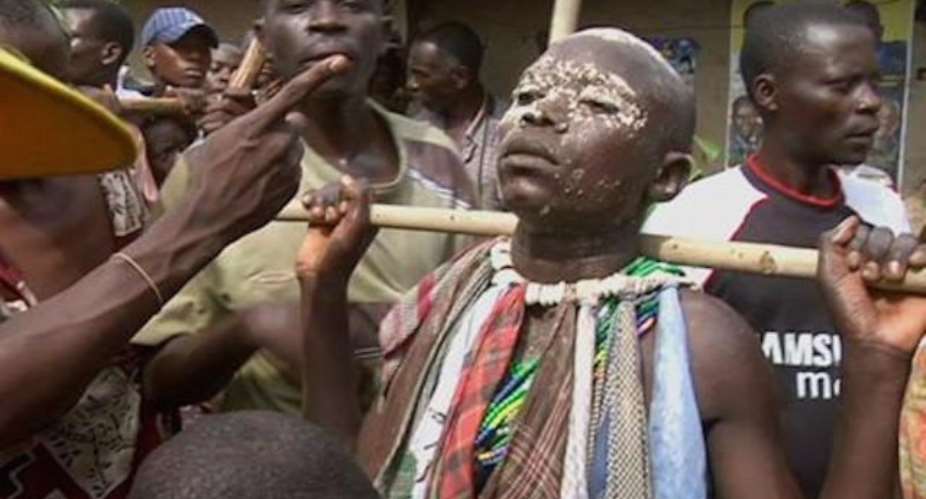Every two years, the Bugisu region in eastern Uganda goes into a festive mood with celebrations surrounding a ritual called Imbalu. In villages throughout the area, young men will step up to have their foreskins shorn in front of their elders, parents, and peers.
If they show no signs of weakness—no flinching or wincing or tears—they are considered to have reached manhood and will be awarded livestock, money, mobile phones, and other gifts.
The Imbalu season happens every two years on even years, and this year's festivities kicked off over a weekend in early August on the Mutoto cultural grounds in eastern Uganda, outside the town of Mbale.
According to Vincent Mugaba, a spokesperson for the Uganda Tourism Board, more than 30,000 people showed up for three days of festivities. Locals and foreign tourists alike camped out to drink home-brewed millet beer, roast bulls and watch a traditional dance performance called kadodi . It all culminated in the circumcision of 100 young "candidates," who usually range in age from late teens to early 20s.
"The Imbalu festival was a huge success," Eddy Kirya, owner of the local Mbale Tours travel agency, told VICE.
Tourism is one of the biggest industries in Uganda. But the east African nation has also been losing an estimated $1 million a day due to the fighting in neighboring South Sudan. There are high hopes that this biannual circumcision ceremony can help fuel tourism and bring more funds to the region.
"My interest is to ensure that as many people come to visit the grounds as possible," Stephen Asiimwe, CEO of the government-run Uganda Tourism Board, told VICE. "Even [to] some Ugandans, especially the younger generation, it's very interesting. They've never seen someone going under a knife, openly, without making a sound."
According to Asiimwe, tourism currently brings in $1.4 billion per year, a huge rise from the $700,000 in revenues of 2007. There are plenty for visitors to explore—from the white-water rapids at the source of the White Nile to the massive gorillas in the fertile national parks of southwestern Uganda. There's also lots of money to be made for locals and the government; just getting a permit to go gorilla tracking will cost an aspiring adventurer $600.
In the Mbale area, nestled next to the extinct volcano of Mount Elgon near the Kenyan border, Kirya says there have been talks about building a cultural center and circumcision museum, opening up new restaurants, and to spruce up the Mutoto grounds with better grass and landscaping to bring in visitors year-round. Asiimwe says an architect recently sketched out a vision for a modern cultural facility, the latest step in plans that have been in the works for the past couple of years with the support of local leaders.
"We have cherished this ritual for more than 200 years," Omar Njofu, chairperson of the Mbale-based cultural council Inzu Ya Masaaba, told Ugandan newspaper the Daily Monitor this summer. "It's unique and marketable and developing this site into a tourism center is of great importance."





 Former Kotoko Player George Asare elected SRC President at PUG Law Faculty
Former Kotoko Player George Asare elected SRC President at PUG Law Faculty
 2024 elections: Consider ‘dumsor’ when casting your votes; NPP deserves less — P...
2024 elections: Consider ‘dumsor’ when casting your votes; NPP deserves less — P...
 You have no grounds to call Mahama incompetent; you’ve failed — Prof. Marfo blas...
You have no grounds to call Mahama incompetent; you’ve failed — Prof. Marfo blas...
 2024 elections: NPP creates better policies for people like us; we’ll vote for B...
2024 elections: NPP creates better policies for people like us; we’ll vote for B...
 Don’t exchange your life for wealth; a sparkle of fire can be your end — Gender ...
Don’t exchange your life for wealth; a sparkle of fire can be your end — Gender ...
 Ghana’s newly installed Poland train reportedly involved in accident while on a ...
Ghana’s newly installed Poland train reportedly involved in accident while on a ...
 Chieftaincy disputes: Government imposes 4pm to 7am curfew on Sampa township
Chieftaincy disputes: Government imposes 4pm to 7am curfew on Sampa township
 Franklin Cudjoe fumes at unaccountable wasteful executive living large at the ex...
Franklin Cudjoe fumes at unaccountable wasteful executive living large at the ex...
 I'll 'stoop too low' for votes; I'm never moved by your propaganda — Oquaye Jnr ...
I'll 'stoop too low' for votes; I'm never moved by your propaganda — Oquaye Jnr ...
 Kumasi Thermal Plant commissioning: I pray God opens the eyes of leaders who don...
Kumasi Thermal Plant commissioning: I pray God opens the eyes of leaders who don...
